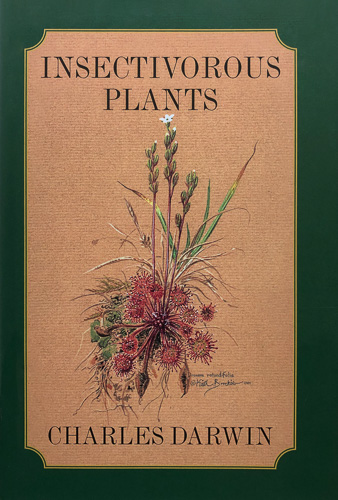
One of Charles Darwin’s more endearing characteristics was the way in which he could become completely absorbed in some apparently trivial side-project. The opening paragraph of Insectivorous Plants describes the genesis of one such project:
During the summer of 1860, I was surprised by finding how large a number of insects were caught by the leaves of the common sun-dew (Drosera rotundifolia) on a heath in Sussex. I had heard that insects were thus caught, but knew nothing further on the subject. […] Many plants cause the death of insects, for instance the sticky buds of the horse-chestnut (Aesculus hippocastanum), without thereby receiving, as far as we can perceive, any advantage; but it was soon evident that Drosera was excellently adapted for the special purpose of catching insects, so that the subject seemed well worthy of investigation.
Most of Darwin’s book Insectivorous Plants, published 15 years after this chance encounter on a Sussex heath, is taken up with investigating the common sundew. It’s Darwin at his most Darwinian, packed with detailed observations and ingenious little experiments. He devised all manner of tests to investigate the movement and co-ordination of Drosera’s sticky ‘tentacles’; to establish what triggered them; and to show how the plants digest their captured food. Typical of Darwin, some of his tests seem more than a little bizarre. Feeding fragments of a cat’s ear and a dog’s tooth to the plants were two of my favourite examples. But, as ever, there was logic behind his enthusiastic eccentricity.
Darwin himself realised he might be going a bit over the top with his experiments, describing them as ‘twaddle’ to his best friend, Joseph Dalton Hooker. His wife, Emma, even joked to a friend that she supposed he hoped to prove Drosera was actually an animal. She wasn’t too far off the mark: in one or two places, Darwin draws our attention to how similar some of Drosera’s features are to those of animals. For example:
A plant of Drosera, with the edges of its leaves curled inwards, so as to form a temporary stomach, with the glands of the closely inflected tentacles pouring forth their acid secretion, which dissolves animal matter, afterwards to be absorbed, may be said to feed like an animal.
In reality, Darwin seems to have wanted to show how such unusual adaptations (for a plant) function, and how they could have arisen. Darwin was a details man: his wonderful theory of evolution by means of Natural Selection explains the weird, little anomalies, as well as the grand themes.
The later chapters of this book deal with other insectivorous plants such as Venus fly-traps and bladderworts, but Darwin’s beloved Drosera rotundifolia is really the star of the show.
A wonderful read.
- Buy this book from Bookshop.org (UK) and help tax-paying, independent bookshops.
- Buy this book from Amazon.co.uk
- Buy this book from Amazon.com